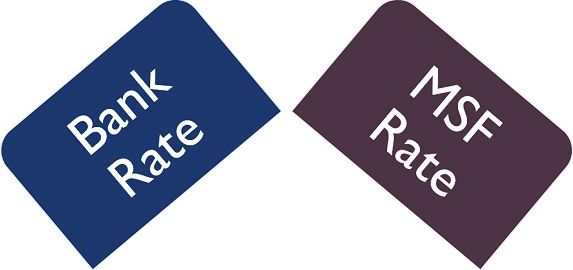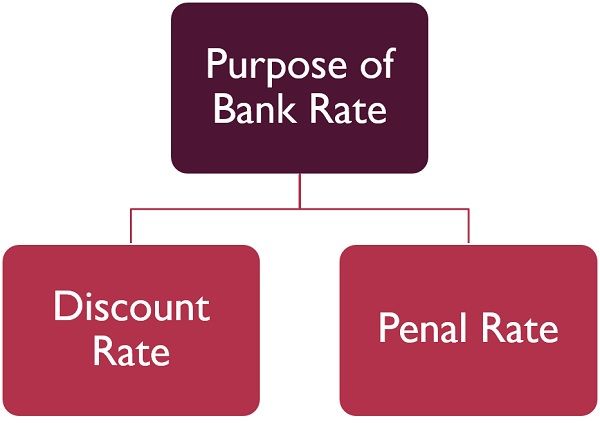 In our monetary policy rate series, we have already discussed the CRR and SLR, Repo Rate and Reverse Repo Rate. So, in this session, we will go through the bank rate and MSF rate. The bank rate can be understood as the interest rate at which commercial banks borrow money from the central bank without any sale of securities.
In our monetary policy rate series, we have already discussed the CRR and SLR, Repo Rate and Reverse Repo Rate. So, in this session, we will go through the bank rate and MSF rate. The bank rate can be understood as the interest rate at which commercial banks borrow money from the central bank without any sale of securities.
On the other hand, MSF Rate is the rate of interest at which commercial banks borrow funds overnight from the central bank, by giving government securities as collateral.
Did You Know?
- Bank Rate is the rate at which the central bank is ready to purchase the financial instruments, that are covered under section 49 of the RBI Act, 1934. It helps in maintaining the overall credit situation in the country.
- MSF stands for Marginal Standing Facility. It is a facility availed by the banks only when the excess SLR of their Net Demand and Time Liabilities (NDTL) has been exhausted. In this facility, banks are required to pay interest, at a rate that is 100 bps greater than the repo rate, which is known as MSF Rate.
- Previously, Bank Rate was regarded as the key policy rate, that directs market interest rates. However, Repo Rate has become the key policy rate, after its introduction.
This post is all about the difference between Bank Rate and MSF Rate. Let us understand it together.
Content: Bank Rate Vs MSF Rate
Comparison Chart
| Basis for Comparison | Bank Rate | MSF Rate |
|---|---|---|
| Meaning | Bank Rate is a discount rate at which RBI grants long term loans to commercial banks. | MSF Rate is a rate at which the commercial banks borrow funds overnight from the central bank. |
| Eligibility | All commercial banks. | All Scheduled Commercial Banks (SCBs) having their current account and Subsidiary General Ledger (SGL) with an RBI. |
| Meant for | Long term Lending | Overnight Lending |
| Collateral | The loan can be raised without pledging the securities. | The loan is given against security within the limits of SLR and up to a certain percentage of NDTL. |
| Objective | To manage and control credit supply in the country. | To provide funds to the banks overnight, when they face an acute shortage of funds. |
Definition of Bank Rate
As per Section 49, of RBI Act, 1934, initially, the bank rate was introduced as a benchmark rate at which the central bank is ready to purchase or rediscount bills of exchange and other instruments, which are qualified for purchase under the Act. However, with the emergence of the Liquidity Adjustment Facility (LAF), discounting or rediscounting of bills of exchange using bank rate has been discontinued by the RBI.
Resultantly, the bank rate turns out as inoperative, as a tool for monetary management. Hence, the Bank rate is aligned to MSF Rate.
Purpose of Bank Rate
The two main purposes for which Bank Rate are used:
- Discount Rate: When banks rediscount bills of exchange and promissory notes from RBI, the rate used for rediscounting is the bank rate.
- Penal Rate: In case the commercial banks fail to fulfil CRR or SLR requirements, the penalty is levied by the Reserve Bank:
- Bank Rate + 3% on the first day.
- Bank Rate + 5% on subsequent day.
Bank Rate
Usually, Bank Rate = Repo Rate + X%
However, at first Bank Rate = Repo Rate + 1%. So, the X% is decided by the RBI.
As of Feb 2021, the Bank rate is at 4.25%
Also Read: Difference Between Bank Rate and Repo Rate
Definition of MSF Rate
To understand MSF Rate, first of all, you need to understand the Marginal Standing Facility (MSF). In the event of an emergency when interbank liquidity ceases completely, a marginal standing facility is available for the scheduled commercial bank to borrow money from RBI overnight.
In this facility, the scheduled commercial banks can borrow funds from the central bank overnight, against the government-approved securities of Statutory Liquidity Ratio (SLR) quota (which is in excess of the current SLR) up to a certain percentage of their Net Demand and Time Liabilities.
Hence, in order to meet additional liquidity needs banks can avail overnight funds from the Reserve Bank using the MSF facility. In this facility, funds are available to the banks at a higher rate of interest, which usually greater than the policy repo rate, which is called as MSF Rate.
The borrowing can be made against the excess SLR securities. Further, the commercial banks are allowed to go down up to two percentage points, below the stipulated SLR, so as to avail funds under MSF.
Issues with Repo Lending
Repo Rate was introduced with an aim of influencing liquidity in the economy. It is the rate at which RBI provides loan to the banks. However, there were significant issues with Repo Lending, which are:
- Liquidity crunch experienced by the commercial banks, even when they avail loan from RBI @ Repo Rate.
- Interbank lending rates were highly volatile.
Purpose of MSF
The marginal standing facility was introduced to overcome these issues:
- To provide liquidity to the system, over and above the Repo lending.
- To control the volatility of the overnight interbank market.
MSF Rate
Usually, MSF Rate = Repo Rate + X%
However, at first MSF Rate = Repo Rate +1%. So, the X% is decided by the RBI.
As of Feb 2021, the MSF rate is at 4.25%
Marginal Standing Facility is allowed to scheduled bank only. Further, banks are permitted to use the marginal standing facility only after using up excess SLR of their NDTL.
Also Read: Difference Between Repo Rate and MSF Rate
Key Differences Between Bank Rate and MSF Rate
The differences between bank rate and MSF rate are elaborated in the points given below:
- Bank Rate was introduced as a standard rate at which the RBI is ready to purchase or rediscount bills of exchange and other instruments, which are qualified for purchase under the Act. On the other hand, Marginal Standing Facility was introduced by RBI in the year 2011. In this facility, the Scheduled Commercial Banks are allowed to borrow money from the Reserve Bank @1% higher than the prevalent Repo Rate, which is called as MSF Rate.
- All commercial banks are eligible for the availing loan at bank rate from RBI whereas MSF Rate is available only to the Scheduled Commercial Banks (SCBs) having their current account and Subsidiary General Ledger (SGL) with the RBI.
- In the case of bank rate, the loan can be raised from RBI, without giving securities as collateral. But, the mechanism of MSF resembles Repo Lending Mechanism, wherein RBI provides a loan to banks over and above the Repo Lending, against collateral.
- Bank Rate is meant for long term lending, whereas MSF Rate is used for overnight lending.
- Bank Rate is a tool used by RBI to manage and control credit supply in the country. Conversely, MSF Rate is a mechanism to provide funds to the banks overnight, when they face an acute shortage of funds.
Similarities
- Both are Bank policy rates that are prescribed by RBI and revised periodically.
- The rate of interest is X% higher than the prevalent Repo Rate.
Salient Features of Marginal Standing Facility (MSF)
The salient features of MSF are represented here:
Come let’s discuss them one by one:
| Eligibility | This facility is available to every scheduled bank having their current account and Subsidiary General Ledger (SGL) with the RBI. |
| Tenor and Amount | As per this facility, the eligible banks can get overnight loans, up to 1% of their concerned Net Demand and Time Liabilities (NDTL) outstanding at the end of the second preceding fortnight. |
| Rate of Interest | The rate of interest on the amount borrowed will be 1% or say 100 bps higher than the ongoing Repo Rate, or as determined by the central bank. |
| Lending Mechanism | Similar to Repo Rate, i.e. the bank sells government securities as collateral to RBI and promises to repurchase it back after the predetermined period, at an agreed rate. And, the difference between the sale and purchase, is the interest rate earned by the Central Bank. |
| Submission of Requests | Requests are submitted online via the Negotiated Dealing System (NDS). It is an electronic trading system run by the Reserve Bank of India that helps in the issuance and exchange of government securities and other money market instruments. However, the physical request can also be submitted, subject to the eligible members are facing genuine system issues. |
| Minimum Request Size | Minimum ₹ 1 crore or Multiples of ₹ 1 crore |
| Collateral | Government Securities under the SLR requirement can be considered as collateral. |
| Discretion of Reserve Bank | Reserve bank has exclusive rights to accept or reject the request submitted by the banks, either partially or fully. |
| Settlement of Transactions | All request received under this scheme are settled on the same day after the closure of the window for acceptance. |
Conclusion
So, we can say that MSF is a special window for scheduled commercial banks to avail loans from RBI against government-approved securities, in case of deficiency of funds and the rate at which marginal standing facility is provided is called MSF rate. Conversely, the bank rate was introduced as the standard rate which directs market interest rates.






Leave a Reply